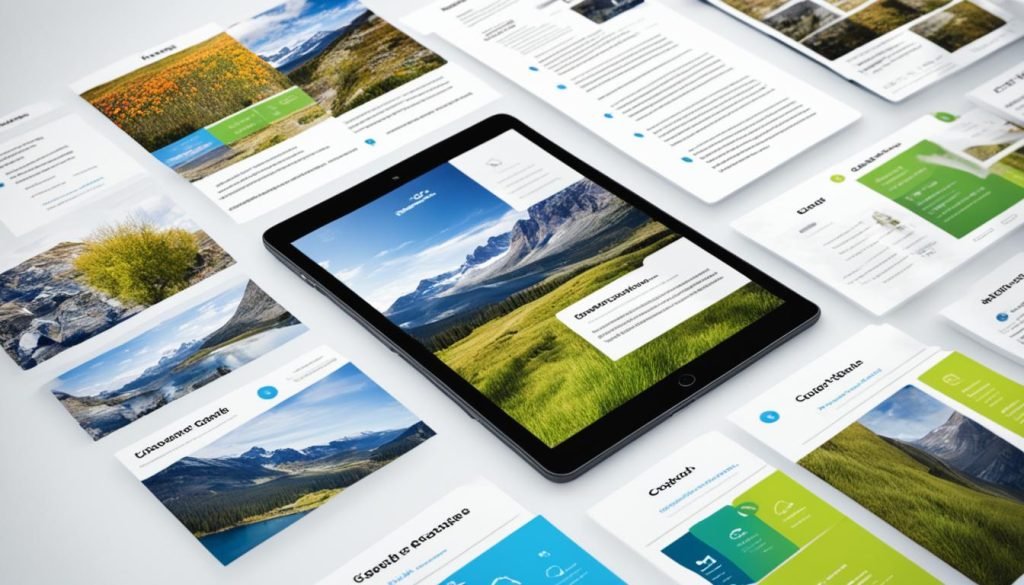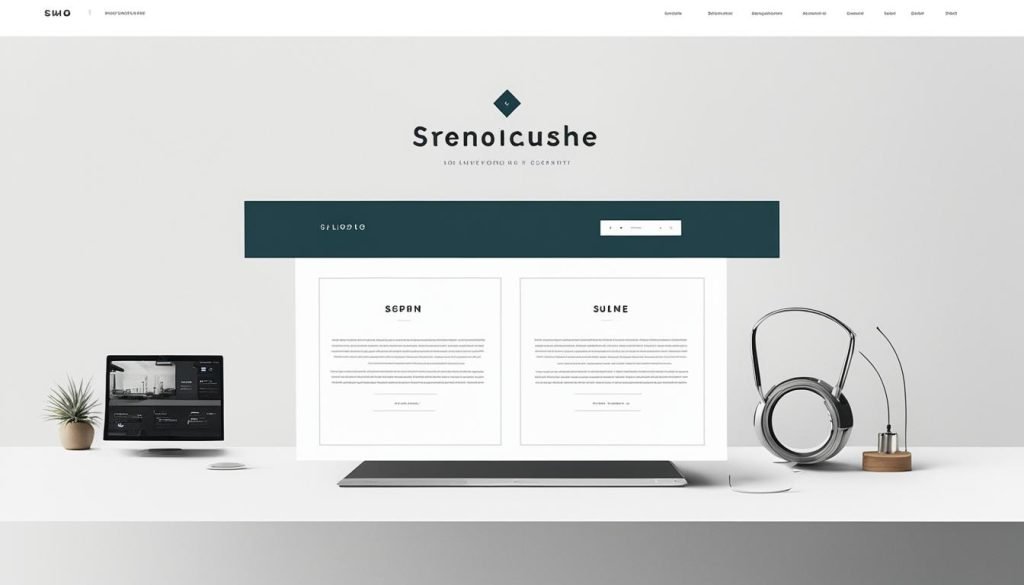Imagine looking online for new running shoes. You find a site that’s outdated and hard to use. Quickly, you search for a better site. Think if someone felt this way about your website. Would they stay and buy something? Learn the fundamentals of website design with our ultimate guide for beginners. Master essential tips, tools, and techniques to create stunning websites.
Knowing basic website design is key. It helps whether you’re running a business, blogging, or freelancing. Good design involves web development, responsive layouts, SEO, and engaging content. These elements draw in and keep visitors.
This article will cover the core parts of great website design. We’ll talk about user experience, mobile-friendliness, graphic design, and using a CMS. With these skills, you can make a website that looks good and is easy to use. You’ll stand out from others.
Key Takeaways:
- Website design is key to a good user experience and drawing visitors.
- Responsive design makes your site look good on all devices.
- SEO helps more people find your website naturally.
- Being mobile-friendly is important as lots of people browse on phones.
- Strong graphic design makes your site more attractive and engaging.
The Importance of Responsive Design
In our digital world, a website must look good on all devices. This is crucial. Responsive design lets your website adjust to any screen size. This means it looks and works well everywhere.
More and more, people use smartphones and tablets for the web. Your site must be easy to use on these. With responsive design, your website shines on smaller screens. This makes it easy for people to explore your site.
Responsive design is good for more than looks. It helps your site show up in search results. Google likes sites that look good on phones. So, responsive design can make your site more visible online.
Also, responsive design means one website works on all devices. No need for different versions for phones or desktops. This makes managing your site simpler. You save time and resources.
Responsive design is a must-have today. Without it, you might lose visitors or customers. It boosts both the user experience and your site’s ranking on search engines. It’s key to a successful website.
Choosing responsive design keeps your site looking great, on any device. Desktop, tablet, or phone, your website will be inviting. So, invest in responsive design. Stay ahead in our fast-changing digital world.
Enhancing User Experience (UX)
User experience is key in good website design. It includes various factors that make browsing better for visitors. Making user experience a top priority helps create a site that looks good and makes your audience happy.
A user-friendly interface helps guide visitors around your website. Easy navigation lets users quickly find what they need. By keeping content organized and links clear, you make browsing smooth.
“A well-designed user interface creates a smooth flow of interaction, making it effortless for users to access the desired information and complete desired actions.” – John Harris, UX Designer
Good content is also important for user experience. Quality and relevant content grabs attention and keeps people on your site longer. It’s key to know what your audience likes and give them content they enjoy. This could be articles, images, interactive bits, or videos.
Website loading speed is very important too. Users want fast-loading sites. If not, they may leave. Making your site perform better, like making files smaller and using caching, helps loading speed.
Having a mobile-friendly website is crucial. More people use smartphones and tablets to browse. A responsive design works well on any device. This makes sure mobile users have a good experience too.
Focusing on user experience brings many benefits. It makes customers happier and more likely to return. It could also boost your site’s conversions. When visitors enjoy your site and find it easy to use, they’re more likely to act, like buy something or sign up for news.
Next, we’ll look at how SEO optimization helps make your website more visible. Good SEO can improve your site’s user experience and bring more visitors.
The Role of SEO Optimization
In today’s online world, SEO is very important for your website’s success. It makes your site more visible, brings more visitors, and helps your online presence grow.
SEO optimization uses many strategies to make your site rank higher in search results. Knowing the basics helps you make your website better and get top rankings.
Using the right keywords is key. Find and use words related to your business. This helps you show up when people search for those words.
Putting keywords in your content is important. But, make sure it’s natural and don’t overdo it. Too many keywords can hurt your ranking.
Meta tags also matter a lot for SEO. They give search engines information about your site. This helps determine how relevant your site is to what people are searching for.
Creating good content is crucial. It should be interesting, informative, and engaging. Good content keeps visitors on your site longer. It can also turn them into customers or clients.
It’s important to check how your website is doing. Use tools like Google Analytics to get insights. This data helps you see what needs improvement to make your website better.
Benefits of SEO Optimization
SEO optimization has many benefits for your site and business. Here are some main ones:
- It makes your website more visible on search results pages.
- Attracting organic traffic means less spending on ads and more potential customers.
- SEO makes your site easier to use, giving visitors a better experience.
- High rankings make your brand seem more trustworthy and credible.
- The benefits of SEO last long. It keeps your site visible over time, unlike ads.
Learning about SEO and using strategic approaches can really boost your site’s visibility. It attracts the right traffic and helps you reach your online goals.
| SEO Optimization Techniques | Benefits |
|---|---|
| Keyword research and integration | Increase website visibility on search engine results pages |
| Optimized meta tags | Improve click-through rates and attract more qualified leads |
| High-quality, engaging content | Build brand authority, engage visitors, and increase conversions |
| Website speed optimization | Enhance user experience and reduce bounce rates |
| Mobile optimization | Reach a wider audience and improve user satisfaction |
| Link building | Improve website authority and increase referral traffic |
For the best SEO results, working with a professional agency or specialist is recommended. They can guide you to apply the best strategies for your site.
The Significance of Mobile Compatibility
These days, having a mobile-friendly website is key. People use their phones and tablets a lot. They look for information, shop, and connect with businesses. So, your website must work well on mobiles. This way, you give mobile users a good experience.
Mobile compatibility means making websites that look good on all screens. This makes sure your site’s look, content, and features work well on mobiles. So, users find it easy to use your website.
Having a mobile-ready site brings many pluses. First, it helps you reach more people. Many use the web on their phones. This opens up chances to meet new customers and grow online.
Also, mobile-friendly sites make users happy. They can easily browse, read, and use your site. This good experience makes them want to stay longer and look around more.
Responsive design is important for mobile sites. It makes your site look great on mobiles. Your website adjusts to any screen size. So, it stays easy and nice to look at, no matter the device.
In the end, a mobile-ready website is a must today. It lets you reach more people, makes users happier, and improves your site. Make mobile compatibility part of your web design plan. It will help your site grow and succeed.
The Role of Graphic Design
Graphic design is vital in website design. It makes your site look good. This includes cool logos, stunning images, and nice layouts. Good graphic design grabs people’s attention. It also makes them remember your site.
Visuals help share your brand’s story. They make your online presence strong. Good graphic design makes your visuals match your brand. This helps people understand what you stand for.
Logos are very important in graphic design. They show your brand’s heart with a single picture. The right colors and pictures make your logo speak for your brand. A great logo sticks in people’s minds.
“Good design is good business.” – Thomas Watson Jr.
Choosing the right images is also key. The best images touch people’s feelings. They make your site more interesting. Good images tell people more about what you offer.
How you lay out your website matters too. It should look good and be easy to use. A well-set-out site helps people find what they need quickly. This makes them like your website more.
Using graphic design smartly makes your website stand out. Focus on logos, images, and layout. These things tell your brand’s story. They also get people interested in your site. And set you apart from others.
Think of graphic design as more than just making your website pretty. It builds your brand. It shares your story. And it makes visiting your site a good experience. Hiring graphic design pros can make your site not only look good but feel good too.
The Benefits of CMS Integration
Managing a website can be tough without much technical knowledge. CMS integration helps a lot. It makes updating your website simple and quick.
Simplified Content Management
With CMS integration, you don’t need to know coding to manage your website. It lets you add, change, and sort content easily. This makes things like posting blogs or updating products simple and quick.
Efficient Collaboration
Multiple people can work on the website together with CMS integration. You can set roles and what they can access. This helps teams work better together and keeps your site updated.
Enhanced Customization
Customizing your website is easy with CMS. You can change designs to fit your brand. This makes your site look special and more appealing.
SEO-Friendly Features
SEO helps people find your website easier. CMS comes with tools to improve SEO, like keywords and URLs. This makes your website more visible online.
Data Security and Backup
Keeping your website’s info safe is important. CMS includes backups and security to protect your data. If something goes wrong, you can get your site back fast.
Overall, CMS integration offers massive help in managing websites. It boosts teamwork, lets you customize, improves SEO, and keeps data safe. With CMS, you can make great content and keep your site running smoothly.

Implementing Effective Navigation
Website design needs good navigation for a happy user experience. It helps people find information easily. Organise content so users find what they need quickly.
Easy navigation keeps users on your site. They enjoy their visit more. It reduces bounce rates and boosts satisfaction.
To make navigation work well, think about:
- Clear and Consistent Menu Structure: Have a simple menu. This lets users move around your site easily. Each menu item should be named clearly.
- User-friendly Dropdown Menus: Dropdown menus are great for lots of content. They help users find what they need without trouble. It keeps things tidy.
- Breadcrumb Navigation: Use breadcrumb navigation. It shows users where they are on your site. It helps them go back steps easily.
- Search Functionality: Add a search bar. It makes finding things faster. This is handy for users looking for specific stuff.
- Responsive Design: Your navigation must work on all devices. As many use mobiles, your site should be easy to use everywhere.
Good navigation makes your website better. It makes users happy and helps meet your site’s goals. Keep it structured and easy to use.
Pro Tip: User Testing
Test your website before it goes live. Have people try your navigation and give feedback. Use their thoughts to improve. This makes sure your navigation is as good as it can be.
Incorporating Engaging Content
Keeping your website visitors hooked is all about quality content. Create stuff that’s both interesting and useful. This way, you’ll seem more credible, encourage interaction, and boost sales. Good content makes your site more enjoyable for visitors.
Here are some tips for great content:
- Create Compelling Headlines: Make headlines that grab attention and make people want to read more. Short, clear headlines that show the value of your content can really draw people in.
- Use Visuals to Enhance the Message: Add eye-catching images, infographics, or videos to your content. These visuals grab attention and make your message clearer, making your content stick in people’s minds.
- Implement Interactive Features: Get people involved with polls, quizzes, or surveys in your content. This boosts engagement and gives you insights into what your audience likes.
- Include Relevant Links: Use internal and external links to give more information and discuss topics further. This makes the user experience better by offering deeper insights and keeps visitors on your site longer.
Focus on making your content enjoyable to read and valuable. Good content is key for keeping your audience interested and seeing your site as reliable. By offering top-notch content consistently, you’ll gain dedicated followers.
“The key to engaging content is to provide value, captivate your audience, and create an immersive experience that keeps them coming back for more.”
Use these tips when making content to improve your website’s feel and connect better with visitors. Engaging content helps in building loyalty and making your site a top choice for useful info.
Examples of Engaging Content
Check out these examples of captivating content:
| Example | Description |
|---|---|
| 1 | A visually stunning infographic that presents complex data in a visually appealing and easy-to-understand format. |
| 2 | A blog post that incorporates interactive elements such as a embedded quiz or interactive timeline to encourage user participation. |
| 3 | A video tutorial that provides step-by-step instructions on a particular topic, engaging users with dynamic visuals and auditory information. |

These instances show that engaging content can come in many forms. Try different formats to see what your audience likes best.
Regular Website Maintenance
Maintaining your website regularly is key for the best performance and user happiness. Check for and fix broken links often. Broken links frustrate users and harm your site’s trustworthiness.
It’s vital to update your plugins and software. This keeps your site secure and working right. Old plugins can be risky and might not work with new web tech.
Fast loading times are a must for a good user experience. Slow sites make visitors leave. By making your site fast, people enjoy visiting it more.
Always back up your website. If something goes wrong, a backup lets you quickly fix it. Backups keep your data safe and give you peace of mind.
Looking For Affordable Web Design and Digital Marketing?
AM Web Design and Digital Marketing provides professional web design services at a price that you can afford. If you have any questions or want to know more about how we can help your business grow, contact us today on 0191 5111009.
You can check out our reviews on our Google Business Profile and see why we would be the right choice for you.



